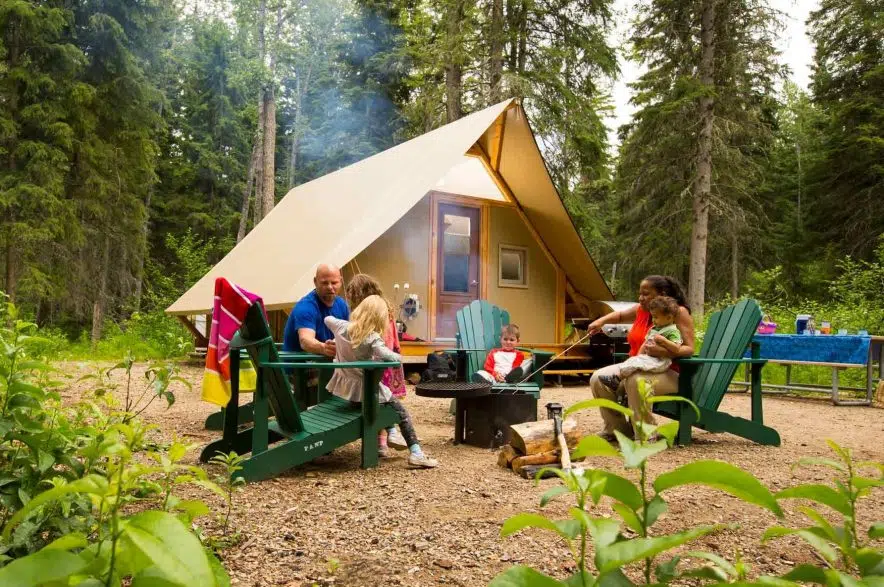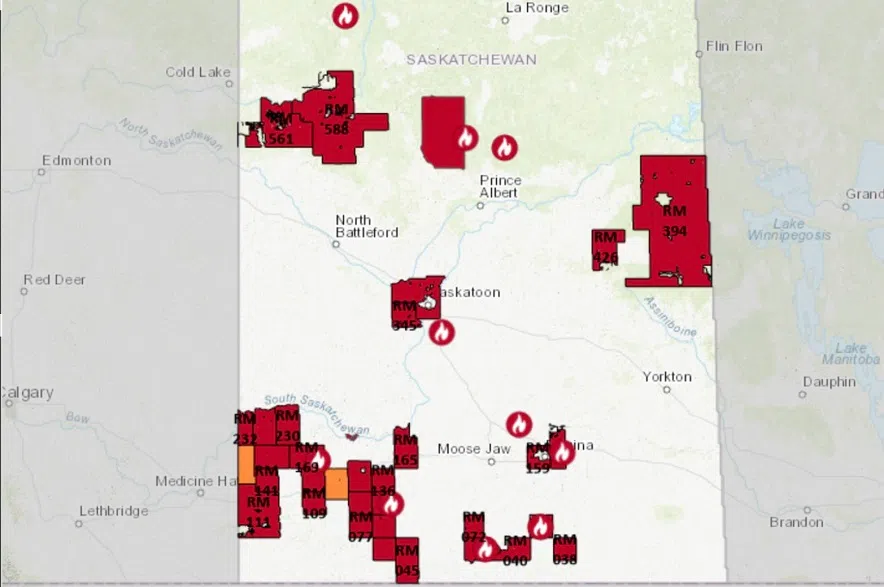With extreme heat forecast to continue in Saskatchewan over the long weekend, several areas of Saskatchewan have fire bans in place because of tinder-dry conditions.
According to the Saskatchewan Public Safety Agency (SPSA) website there were 37 active fire bans in rural municipalities, 12 active fire bans in urban municipalities and five active fire bans in provincial parks on Aug. 2.
A province-wide fire ban was lifted on July 26 due to rainfall and cooler weather.
Steve Roberts, vice president of operations for SPSA, said the provincial ban had been focused on the northern forest, and rain in areas north of La Ronge had lessened that fire risk.
But, Roberts said, the area of concern for fire risk has shifted.
“Our largest fire hazards right now in the province are actually near the southern border and the agricultural land south of Saskatoon,” he said.
Several local communities have issued fire bans, many in the southwest of the province extending from areas around Swift Current to the Alberta and American border.
Communities with their own bans include Vanguard and Hazlet and the RMs of Morse, Mankota, Glen McPherson, Auvergne, Whiska Creek, Coulee, Swift Current, Lac Pelletier, Wise Creek, Carmichael, Gull Lake, Pittville, Clinworth, Happyland, Fox Valley, Big Stick, Maple Creek and Deer Forks. Fire restrictions are in place in the RMs of Webb and Enterprise.
Around Saskatoon there are fire bans in the RMs of Corman Park and Vanscoy, and in Shields, near Blackstrap.
Around the Regina area, there are fire bans in the RMs of Sherwood and Balgonie and the communities of Balgonie and Pelican Pointe.
To the south are fire bans in the communities of Willow Brunch and Pangman, and in the RMs of Lake of the Rivers, Willow Brunch, Bengough, Norton, and Laurier.
In the northwest there are fire bans in the RMs of Meadow Lake and Loon Lake and in Jans Bay. North of Prince Albert there are fire bans in the communities of Elk Ridge and Candle Lake.
In the northeast there are fire bans in place in the RMs of Hudson Bay and Bjorkdale.
Provincial parks where fire bans are in effect are Prince Albert National Park, Fort Carlton Provincial Park, Pike Lake Provincial Park, Blackstrap Provincial Park, Porcupine Hills Area Provincial Park, and Saskatchewan Landing Provincial Park.
READ MORE:
- Province issues fire ban due to hot, dry conditions across Sask.
- Here’s what to do if you suspect someone has heatstroke
As of August 2, there were 86 active wildfires in the province and eight are not contained. There have been 431 wildfires so far in 2024 in Saskatchewan, well above the normal five year average of 307.
The fire risk was extreme for almost the entire southern portion of the province, south of Prince Albert. Much of the north is listed as either low or moderate risk, but there are some portions listed as high or extreme.
Roberts explains what has been going on.
“Over the last number of weeks across the whole province we’ve experienced this high temperature dome type of situation with very few breaks,” said Roberts. When showers came through the province, he said, it was through the north.
“The areas south of of Prince Albert, for instance, continue to (be) dry this whole time and are very dry,” said Roberts. He said that is fuel for fires which could spread quickly if combined with wind.
So when is a provincial fire ban issued? Roberts said SPSA looks at “both the current weather hazard conditions province-wide” and what it believes to be the mid-range “seven-to-10 days out weather forecast coming towards us.” It also looks at how much fire activity they have, and the current fire load.
“It’s one of the things that would trigger us to, for instance, put on fire bans — to limit the number of human-caused fires to add to that workload.”

If you are camping in Prince Albert National Park this weekend, take note of the fact a fire ban is in effect. (Parks Canada/Submitted)
People should check SPSA’s website to find out where fire bans are in place, Roberts said.
He also advised people venturing out into the forest to be careful.
“If you’re not careful with fire, careful with your campfires, careful with your ATV use, careful with things like fireworks, for instance, you have a higher likelihood of starting a fire.”
Roberts urges people to “take that little extra bit of caution”.
“We saw what happened in Jasper. We don’t want those kinds of fires, and the last thing we want is a human-caused fire to add to that, where someone’s actually responsible because they didn’t take enough care and attention.”
READ MORE:












